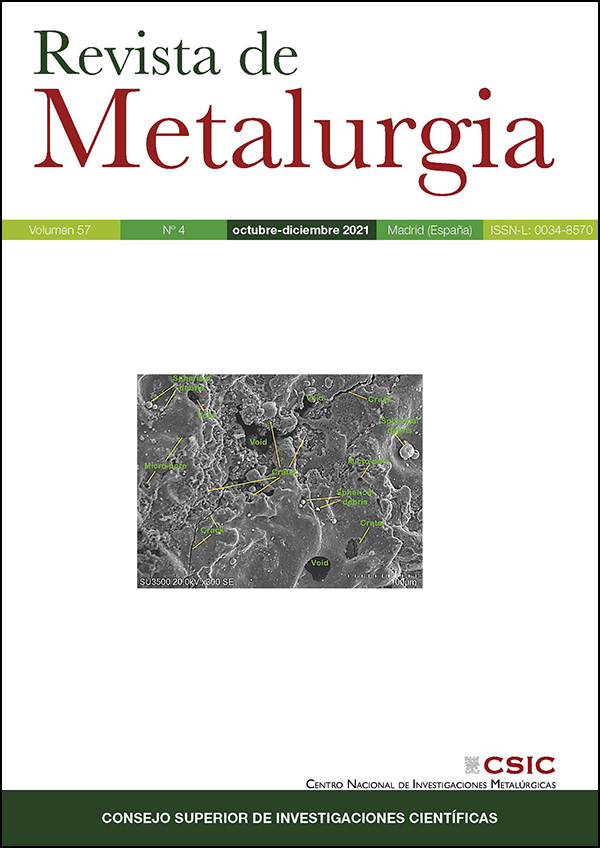Effect of rotary friction welding on mechanical properties of 6060 Al alloy
DOI:
https://doi.org/10.3989/revmetalm.206Keywords:
6060 Al, Friction welding, Mechanical properties, Rotation speed, Solid state weldingAbstract
6xxx series of aluminum alloys are prone to cracking when fusion welded without a proper filler metal. Alternatively, these alloys can be welded by rotary friction welding, a solid-state welding process, without using another material. However, the use of the correct parameters for the rotary friction welding process is a key to get sound welds. In this study, 6060 aluminum alloy was rotary friction welded with various rotation speeds, and the effects of the rotation speeds on the mechanical properties of the welds were studied. The samples were observed under scanning electron microscope, were analyzed using elemental mapping with energy dispersive X-Ray spectroscopy, and tested with micro-hardness and tensile tests. Among the studied samples, the sample welded with the rotation speed of 1700 rpm was found to be much better than the others in terms of the mechanical strength. In the observations made under the microscope, unlike the fusion welding, no cracking or other welding defects or macro segregation was noticed in the sample welded with the speed of 1700 rpm.
Downloads
References
Ahmad Fauzi, M.N., Uday, M.B., Zuhailawati, H., Ismail, A.B. (2010). Microstructure and mechanical properties of alumina-60601 aluminum alloy joined by friction welding. Mater. Desing 31 (2), 670-676. https://doi.org/10.1016/j.matdes.2009.08.019
ASM Handbook (1981). Heat treating of aluminum alloys. 9th Ed., Vol. 4, American Society for Metals, Metals Park, OH, pp. 841-879.
ASTM E8/E8M (2013). Standard Test Methods for Tension Testing of Metallic Materials. ASTM International, West Conshohocken, Pensilvania, EE.UU.
Coniglio, N., Cross, C.E. (2009). Mechanisms for solidification crack initiation and growth in aluminum welding. Metall. Mater. Trans. A 40, 2718-2728. https://doi.org/10.1007/s11661-009-9964-4
Dey, H.C., Ashfaq, M., Bhaduri, A.K., Prasad Rao, K. (2009). Joining of titanium to 304L stainless steel by friction welding. J. Mater. Process. Technol. 209 (18-19), 5862-5870. https://doi.org/10.1016/j.jmatprotec.2009.06.018
Dursun, T., Soutis, C. (2014). Recent developments in advanced aircraft aluminum alloys. Mater. Desing 56, 862-871. https://doi.org/10.1016/j.matdes.2013.12.002
Etesami, S.A., Enayati, M.H., Karimzadeh, F., Rasta, V. (2015). Investigating the properties of friction welded 2014 aluminum joints prepared with different rotational speeds. Trans. Indian Inst. Met. 68 (3), 479-489. https://doi.org/10.1007/s12666-014-0475-7
Fu, B., Qin, G., Li, F., Meng, X., Zhang, J., Wu, C. (2015). Friction stir welding process of dissimilar metals of 6061-T6 aluminum alloy to AZ31B magnesium alloy. J. Mater. Process. Technol. 218, 38-47. https://doi.org/10.1016/j.jmatprotec.2014.11.039
Jha, S.K., Balakumar, D., Paluchamy, R. (2015). Experimental analysis of mechanical properties on AA 6060 and 6061 aluminum alloys. Int. J. Eng. Res. Appl. 5 (4), 47-53.
Kimura, M., Choji, M., Kusaka, M., Seo, K., Fuji, A. (2005). Effect of friction welding conditions and aging treatment on mechanical properties of A7075-T6 aluminium alloy friction joints. Sci. Technol. Weld. Joi. 10 (4), 406-412. https://doi.org/10.1179/174329305X44125
Kimura, M., Choji, M., Kusaka, M., Seo, K., Fuji, A. (2006). Effect of friction welding conditions on mechanical properties of A50502 aluminum alloy friction welded joint. Sci. Technol. Weld. Joi. 11 (2), 209-215. https://doi.org/10.1179/174329306X89242
Kou, S. (2020). Welding Metallurgy. 3rd edition, Wiley and Sons, Hoboken, NJ.
Li, X., Li, J., Jin, F., Xiong, J., Zhang, F. (2018). Effect of rotation speed on friction behavior of rotary friction welding of AA6061-T6 aluminum alloy. Weld. World 62, 923-930. https://doi.org/10.1007/s40194-018-0601-y
Metalreyonu (2021). 6060 Al Mechanical Properties. available at: https://www.metalreyonu.com.tr/icerik/6060.
Othman, N.K., Bakar, S.R.S., Jalar, A., Syarif, J., Ahmad, M.Y. (2010). The effect of filler metals on mechanical properties of 6 mm AA 6061-T6 welded joints. Adv. Mat. Res. 154-155, 873-876. https://doi.org/10.4028/www.scientific.net/AMR.154-155.873
Soysal, T., Kou, S. (2019). Effect of filler metals on solidification cracking susceptibility of Al alloys 2024 and 6061. J. Mater. Process. Technol. 266, 421-428. https://doi.org/10.1016/j.jmatprotec.2018.11.022
Soysal, T. (2020). A criterion to find crack-resistant aluminum alloys to avoid solidification cracking. Sci. Technol. Weld. Joi. 26 (2), 99-105. https://doi.org/10.1080/13621718.2020.1843260
Soysal, T. (2021). A new solidification cracking test: stationary weld-pool deformation test. Sci. Technol. Weld. Join. 26 (8), 622-630. https://doi.org/10.1080/13621718.2021.1985369
Sun, Y., He, D., Xue, F., Lai, R. (2018). Effect of tool rotation speeds on the microstructure and mechanical properties of a dissimilar friction-stir-welded CuCrZr/CuNiCrSi butt joint. Metals 8 (7), 526-541. https://doi.org/10.3390/met8070526
Teker, T. (2013). Evaluation of the metallurgical and mechanical properties of friction-welded joints of dissimilar metal combinations AISI2205/Cu. Int. J. Adv. Manuf. Technol. 66 (1-4), 303-310. https://doi.org/10.1007/s00170-012-4325-7
Teker, T., Yılmaz, S.O., Karakurt, E.M. (2018). Effect of different rotational speed on mechanical and metallurgical properties of friction welded dissimilar steels. Mater. Test. 60 (2), 135-141. https://doi.org/10.3139/120.111135
Teker, T., Karakurt, E.M. (2020). Examination of mechanical properties of high chromium white cast iron/AISI1030 steel welded by friction welding with nickel interlayer. Sci. Technol. Weld. Joi. 25 (2), 150-156. https://doi.org/10.1080/13621718.2019.1648720
Threadgill, P.L., Leonard, A.J., Shercliff, H.R., Withers, P.J. (2009). Friction stir welding of aluminium alloys. Int. Mater. Rev. 54 (2), 49-93. https://doi.org/10.1179/174328009X411136
Published
How to Cite
Issue
Section
License
Copyright (c) 2021 Consejo Superior de Investigaciones Científicas (CSIC)

This work is licensed under a Creative Commons Attribution 4.0 International License.
© CSIC. Manuscripts published in both the printed and online versions of this Journal are the property of Consejo Superior de Investigaciones Científicas, and quoting this source is a requirement for any partial or full reproduction.
All contents of this electronic edition, except where otherwise noted, are distributed under a “Creative Commons Attribution 4.0 International” (CC BY 4.0) License. You may read the basic information and the legal text of the license. The indication of the CC BY 4.0 License must be expressly stated in this way when necessary.
Self-archiving in repositories, personal webpages or similar, of any version other than the published by the Editor, is not allowed.
















